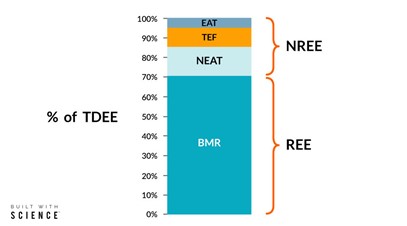Home » Fitness Blog » What is NEAT & How Can it Help us Stay in Shape?
What is NEAT & How Can it Help Us Stay in Shape?
Over the last 10+ years there have been a few mixed messages from the world of sport and exercise science, but one statement has been fairly consistent when it comes to weight loss. We need to “move more”, but when we think of moving more we think more exercise, harder and longer workouts and more intensity sessions, right?
Before I answer that, first let’s take a look at where most of the energy used by the body goes, this is known as Total Daily Energy Expenditure (TDEE).

Let’s go through this one at a time:
Resting Energy Expenditure (REE) constitutes approximately 60-75% of TDEE and includes sleeping metabolism, basal metabolism, and arousal metabolism. REE is the number of calories a body needs at rest to perform basic functions such as the heart beating and keeping the brain functioning.
The rest of the energy used is classified as Non Resting Energy Expenditure (NREE).
TEF is the Thermic Effect of Feeding and constitutes approximately 10% of TDEE. This is the energy being required in the processes of digestion, absorption, and assimilating food nutrients. The magnitude of the TEF can vary depending on both the quantity and type of food eaten.
Physical activity is then broken into two parts Exercise Activity Thermogenesis (EAT), this is purposeful exercise such as running, HIIT, strength training etc and is around 5% of TDEE. The second part is Non Exercise Activity Thermogenesis (NEAT). This is the most variable component of metabolism and can make up anything from 15-20% of TDEE.
What Is NEAT?
Non-exercise activity thermogenesis is the amount of energy you use during your daily activities, not including sleeping, eating, or exercising. NEAT can be anything from moving around your kitchen to fidgeting to cleaning your house. Other examples of NEAT include:
- Playing with your kids
- Doing laundry
- Gardening or yard work
- Walking the dog
- Standing
Every movement we make uses energy, and while that expenditure may seem small, these small movements can make a substantial difference as they accumulate over time.
How Effective is NEAT?
Many of us are stuck behind a desk for eight hours a day and the majority of our NEAT comes from minimal activity, like grabbing a cup of coffee or walking to the car. But if you incorporate more movement into your daily routine, you can use up a lot of energy. We think of exercise as the main place we “burn calories”, but the problem with exercise is its time bound. You can utilise up to five times as much energy over the course of the day with NEAT as you can in one hour of training..
NEAT vs EAT for Fat Loss?
Hard exercise or long workouts might use up a bit more energy per session but one of the biggest drawbacks to this is you will start getting very hungry. As the body tries to maintain balance by altering two important hormones ghrelin and leptin, which control satiety and hunger. One of the main benefits of NEAT is that it has actually been shown to help manage these hormones over time. Also staying active throughout the day, can maintain your levels of lipoprotein lipase (LPL), which is an enzyme linked to fat utilisation.
If we only ever think of training hard and eating less, a side-effect of this is that we naturally become more sedentary in order to retain energy. Think about it, when you are sore as hell and wiped out from training are you likely to want to do much afterwards? These periods of inactivity can actually undermine all the hard work you’ve put into at the gym. So, even if you eat well and exercise regularly, NEAT is still important for supporting fat loss.
Fortunately, it’s quite easy to increase NEAT throughout the day.
How Do We Incorporate More NEAT Into Our Daily Routines?
Here are some simple changes to your daily routine that will increase your NEAT:
- Using the stairs instead of the elevator
- Parking in the furthest corner of the parking lot
- Standing instead of sitting at your desk or replacing your chair with a stability ball
- Increasing daily chores, like scrubbing, mopping, degreasing and polishing
- Finding small ways to move when seated, like using a stress ball or tapping your feet
We have become so obsessed with training hard and leaving nothing in the tank that the humble walk has been outcast as an ineffective form of exercise when it’s anything but. Activity that is sustainable is so crucial for health and fat loss. It’s friendly on the joints and you can and should do for the rest of your life.
Copyright © 2019 Andy Vincent PT
Created by DO Digital Marketing


